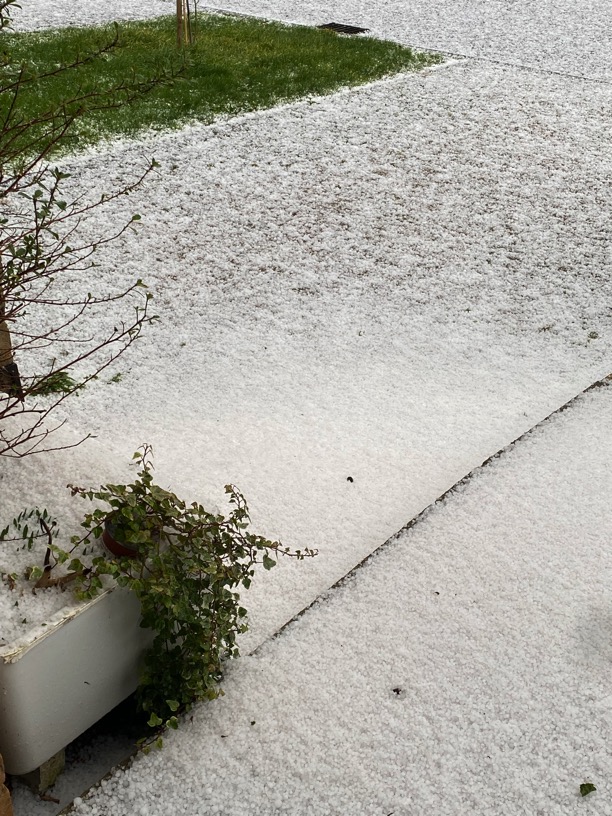
Hail is from OE hagol, which may ultimately be related to Latin calix and Greek κάχληξ, pebble, and so from the same origin as calcium.

Hail is from OE hagol, which may ultimately be related to Latin calix and Greek κάχληξ, pebble, and so from the same origin as calcium.
enclose : indeterminate number of clothes
It being Burn's Night I had haggis with the neeps and tatties and for afters this cranachan, which was very nice indeed.
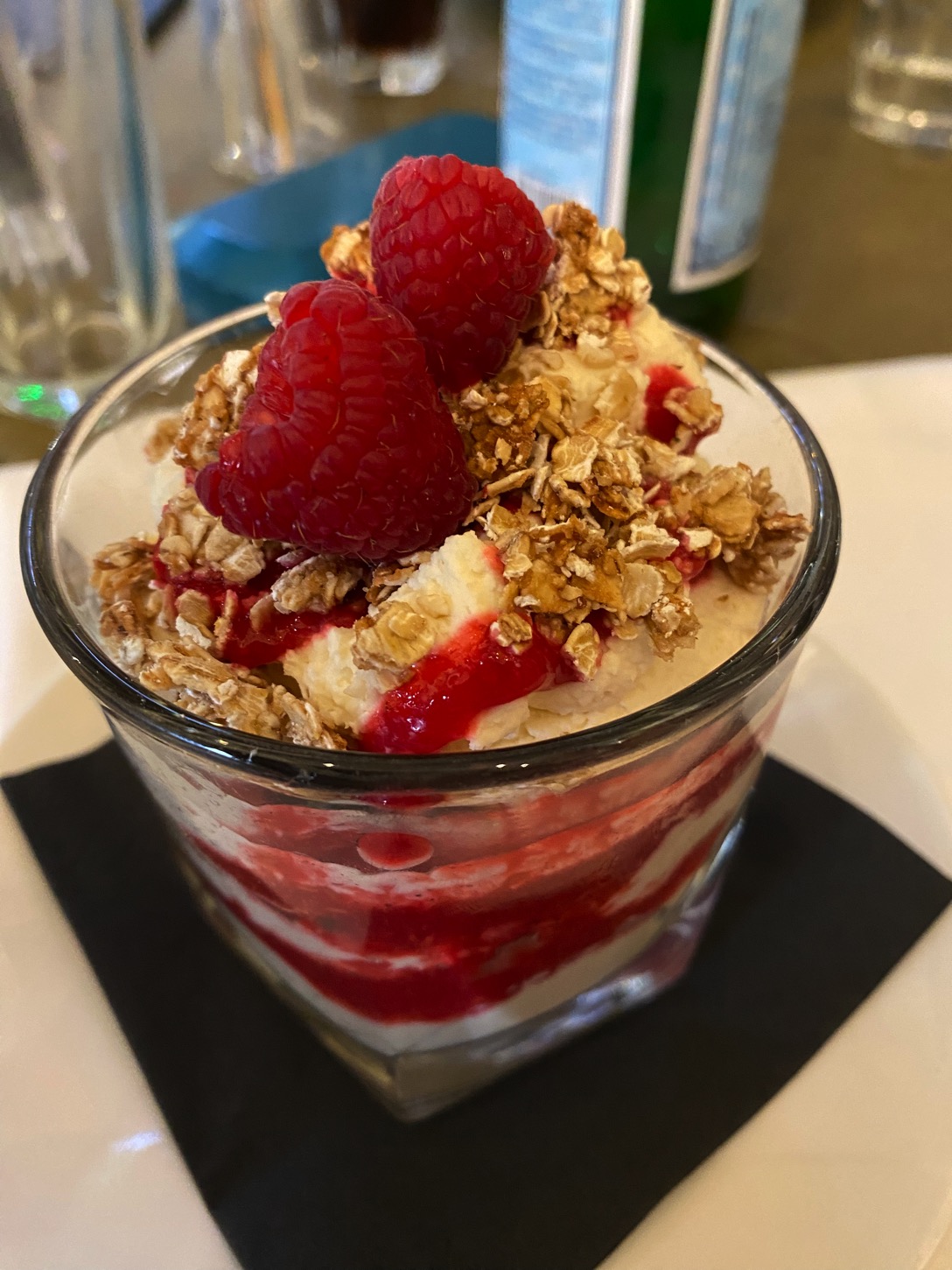
The OED defines the name like this
Scottish.
"A dessert typically made with whipped cream, whisky, oatmeal, honey, and berries (esp. raspberries)."
and although it must be traditional the first citation the OED gives is from 1946.
Previously I posted a well known problem which asks: suppose we are on a circular boating lake when fog descends. We know the size and shape of the lake and can travel any distance and in any direction we please, but we don't know where we are on the lake, so we are rowing blind. What is the shortest distance we must be prepared to row to be sure of escaping from the pond. and what path should we follow?
The answer is that you should row in the straight line until you hit the bank and may have to travel a distance equal to the diameter of the pond, and this cannot be improved on. My proof is here. I actually found this for myself some years ago but it turned out to have already been published 40 year before. so I was late to the party.
A follow up question was: what if we are on a pond in the shape of an equilateral triangle? The diameter of an equilateral triangle is just the length of one of its sides and this is the least escape distance if you keep to a straight line. But rather surprisingly (well I think it is) a zig-zag escape path exists which is shorter, at about 0.98198 of the side length.
Here are two pictures of the path in different positions and you can probably see how it manages to always reach the perimeter of the triangle even though it is shorter than the diameter.

abeyance : behave as your parents' sisters tell you to.
Hammer : From OE hamor, Proto-Germanic (PG) *hamaraz and probably from a word that meant "stone"; possibly derived from a PIE root ak- "sharp" or "tip"and if so related to a whole host of words; some surprising examples are acrobat, acronym, acropolis, oxygen, eager and vinegar.
Saw : From OE saue, PG *säge, from PIE *sek "cut" and related to words such as Saxon, scythe, secateur, section, secant , segment and insect.
Wrench : From OE wrencan, from PG *wrankjan, from PIE *wer- "turn". Related words include adverse, wrangle, wrap, vertex.
neutron : Ronald the newt
electron : vote for Ron!
boson : ship's officer
quark : duck noise
photon : imitation ton
particle : average tickle
“I’m a bit stretched at the moment”, said Tom intentionally.
To reiterate this question, imagine we are rowing on a round pond 200 m across when suddenly fog descends and visibility is effectively zero. You are lost and unfortunately the fog fell too quickly for you to have any idea of your location relative to the pond's edge. What is the shortest distance you can row to guarantee reaching the edge of the pond and what path should you follow?
To begin with, any straight path of length 200 m must be a diameter of the pond. Therefore, if we choose an direction at random (we do not know where the shore lies relative to our location so one direction is as good as another) and travel in a straight line, we are certain to reach the bank after at most 200 m. So this is am escape path.
It's natural to wonder if some ingenious non-linear path might guarantee hitting the pond's edge in a shorter distance, but we can show this is impossible.
Here's the proof.
Suppose we can guarantee reach the shore in a distance of less than 200 m by following some path starting at A and ending at M and let M be the point half-way along the path, so the path length for M to A and to B are both less than 100 m.
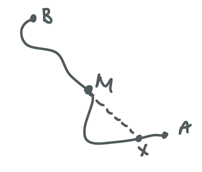
Consider an arbitrary point X somewhere along the path. The distance along the path from M to X must be less than 100 m and the straight line distance from M to X must therefore also be less than 100 m. Since X was an arbitrary point it follows that every point on the path is less than 100 m from M and we can draw a circle with centre M and radius less than 100 m.
But this is smaller than the pond, which has a radius of 100 m! So it's possible for the whole of AB to lie within the interior of the pond and it therefore cannot form a guaranteed escape path.
But I hadn't heard it.
“There's a fairy at the bottom of my garden.”
“Really? What’s the fairy called?"
"Nuff. Fairy Nuff."
In a comment, Steven McDonald already gave a nice solution to the puzzle here. My own solution is equivalent but framed a bit differently; I went for a more visual explanation.
Each of the rectangles we want to count is determined by some two rows and two columns of the 10x10 grid, as shown in this example:

For the rows we have 10 choices for the first, which leaves 9 choices for the second, but that will have double-counted each combination, because for example row 5 and row 9 represents the same pair as row 9 and row 5. So we must divide by 2 and there are
(10 x 9) / 2 = 45
distinct combinations.
Similar reasoning gives 45 of ways to choose two distinct columns and so we find there are 45 x 45 = 2025 different rectangles.
I wrote a program in Python that generates 10,000 (genuinely) random digits 0-9. Then I printed these out as a single long number. It is 375 lines long; here are the first three
831890763767461847514714907504909059910471583635723819115293775185358920959225430857532633499685356491399820546977313764001270746221095521182083788787861672547484439646176036442711628220017949593398149413649851543601589892255388029309553753987882231855967054928709292053025019238151606268592151309301940063808830006628974108
There are 1010,000 such 10,000 digit numbers numbers, and so if you or I run the program again the chances of the same one coming up again are infinitesimally tiny. In fact we can be pretty certain that the same number will never be generated ever again.
So if you ran my program, read the output (takes a while!) and then erased it, you would have seen a number that no-one has seen before or will see again. Your very own number!
This is based on something I saw on YouTube a while ago, I can't recall exactly where.
On this 10 x 10 square grid I have drawn some rectangles with their corners on points of the grid and their sides parallel to the sides of the square. The colours have no particular significance I just used them to make the picture more interesting.

There are obviously many other rectangles that can be drawn on this grid. Can you work out how many there are altogether? Answer on Tuesday.
I didn't know this word but it was the last answer in yesterday's crossword. The cryptic clue was
Line showing equal water depth is over tub (7)
an imaginary line or a line on a map or chart that connects all points having the same depth below a water surface
As well as this meaning the OED provides a second definition, for a special kind of inkwell:
Trade-name for an inkstand with a float so contrived as to keep the ink in the dipping-well at a constant level
Ingenious but I suppose largely obsolete."Your decision to lower the pitch of the doorbell by a semitone was pure genius", said Tom flatteringly.
New Year's wind
Rattling this old house.
Maybe it's time for a shake up.

Merriam-Webster defines it as: "an unrealistic enterprise or prospect of prosperity". What is the expression? The picture above is a clue.
—You've probably seen this puzzle, which goes back to at least 1913 and was not new then.
Three utility companies, Gas, Water and Electricity, want to each connect a supply to three houses, Nos. 1 and 2 and 3 Topology View. For technical reasons they do not want anyone's connect to cross another's. The sketch below shows a partial solution, in which 8 of the 9 connections required have been made without any crossings.

But making the last connection from E to No. 1 seems impossible without a crossing, and indeed it is. A particularly elegant proof is given in this Wikipedia article.
But all of this assumes we are working on a flat plane. What if we change the setting so that suppliers and houses are on a giant donut aka as a torus, as shown below?
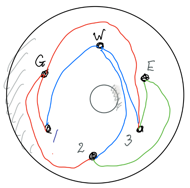
Well now we are on a torus we can take a path for E to No.1 that goes round the back of the torus, up through the hole in the middle, and connects to No.1, as indicated by the dotted line in the next sketch.
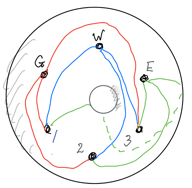
This configuration of two sets of three points (aka vertices), with lines (aka edges) between point in the first set and every point in the second is called the complete K3,3 which is reasonably self-explanatory. It is one of two "special" configurations, the other being K5 . K5 also cannot be drawn in the plane without a crossing, as we see in the next sketch.
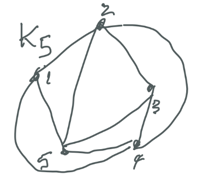
Although I have labelled it K5 that is not quite accurate, because it isn't complete; it ought to have 10 edges. However similar to K3,3 it is impossible to draw it in the plane without two edges crossing.
These two configurations are special because they let us answer the question "What, not necessarily complete, point and line configurations is it possible to draw in the plane without any crossing edges?" The answer is: exactly those configurations that contain no sub-configurations equivalent (in a fairly simple way but I'll skip the detail) to K3,3 or K5.
This is amazing, if you think about it: there are just these two forbidden sub-configurations and if they are avoided any point and line configuration whatsoever of the kinds we have been looking at can be drawn,"embedded", in the plane with no crossings.
Back to the torus. We have seen that K3,3 can be embedded in the surface of a torus, and so can K5 it turns out. In fact we can embed K4,4 (so we could fit in broadband too!) and K7. So we might ask: is there some set of forbidden configurations that let us say what can and cannot be embedded in the surface of a torus, similarly to the way we answered the question for the plane?
The answer is yes there is, but non-one can say yet how many forbidden sub-configurations there are. All that is known at present is that they number at least 17,523. That is the surprise alluded to in the title of this post. When I read that going from the plane to the torus involved a jump from 2 to 17,523 I was staggered!
And of course a torus has only one hole, but we could have 2, 3, 4,... holes and so on, so whatever happens there? It's mind-boggling!

Soon it will be 2025 and that reminded me of an arithmetic trick that used to impress my students, when I was a maths teacher.
Suppose you want to square a number ending in 5, for example 85. Take the first digit, 8, and add 1 to it to get 9.
Now work out 8 x 9 = 72, then put 25 (it's always 25) at the end, giving 7225
And sure enough 85 x 85 is 7225.
This works with any number that ends in 5, for example 1152 is 13225, although doing the calculation in your head obviously gets progressively harder.
What has this to do with 2025? Well 2025 is a square you see; using the method above we find 452 = 2025. This may seem unremarkable, after all, aren't there plenty of square numbers (infinitely many in fact)?
But they get further and further apart the further we travel along the number line – so for example by the time we reach a million only (1,000/1,000,000) x 100% = 0.001% of numbers up to that point are squares. In the long run the proportion of squares gets closer and closer to zero.
And the next square year after 2025 will be 462 = 2116, another 91 years off.
Knock-Knock!
Who’s there?
Some friends' children were walking to church yesterday and were enchanted to see Santa's deer crossing the skyline.

You can see some of them have well-developed antlers and my guess is they were fallow deer, which are common round here, but hard to be sure from so far off.
This blog might contain posts that are only visible to logged-in users, or where only logged-in users can comment. If you have an account on the system, please log in for full access.